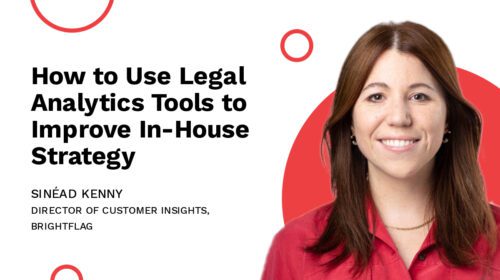Here Are the Reports Your CFO Wants to See From The Legal Department
A chief financial officer (CFO) plays both scorekeeper and strategist for the business. They work with each department to track current cash flow and find better ways of predicting, controlling, and avoiding future expenses.
Before your CFO can provide any of those essential services, however, you need to supply them with accurate and relevant data.
By anticipating their questions and proactively keeping score with the reports below, you’ll reserve more space for your CFO to consider strategic plans that can transform legal department operations.
Part I: “How much have we spent and where?
A department’s record of past expenses is frequently the first place a CFO will look when weighing future decisions and recommendations. Presenting that baseline perspective is deceptively difficult, however, for in-house legal teams.
Spend by Month
Corporate legal spend can be broadly categorized into two groups. The first category contains expenses that are static, predictable, and easy to capture. These are most often internal costs, such as staff salaries, software subscriptions, and continuing education.
The second category contains expenses that are dynamic, unpredictable, and more difficult to capture. These are most often external costs associated with outside counsel engagements.
The ability to quickly and accurately capture that second category of expenses is the first sign of a healthy legal spend management strategy. Conversely, its absence will be your biggest barrier to sophisticated financial planning.
If your team ends most months scrambling to paste invoice subtotals into an Excel spreadsheet, then you’re certainly not doing your CFO any favors. That’s why legal departments have spent the past decade transitioning to more specialized legal spend management software that automates basic expense tracking.

Spend by Department
Corporate legal services reflect the requirements of business departments. That gives in-house legal teams a unique perspective into how their entire organization operates — a view any CFO would be eager to share.
Whether you’re reviewing contracts for Sales or managing litigation for HR, department of origin is a critical label to associate with every legal expense. Sorting spend by department immediately draws a CFO’s attention to where their strategic intervention could have the strongest impact.
Do the legal expenses generated by each department align with the value it creates?
Is there enough activity in a certain area to justify insourcing an expert attorney?
Could significant legal costs be avoided if we invest in more business team training?
These are the kind of questions CFOs depend on legal department data to answer.
Spend by Vendor
Like any business vendor, outside counsel is expected to return a certain level of value in exchange for the money your organization has invested in their services. Cost is not the only variable in the value equation, of course, but it’s the clearest place for a CFO to start their assessment.
Law firms receiving the largest proportion of your outside counsel spend represent the highest-leverage opportunities for strategic financial planning. We’ll discuss the specific value analyses you should run in Part III, but it’s important to build and filter this report first so you can prioritize those efforts.
Part 2: “How much do we expect to spend and where?”
Perhaps the truest measure of a CFO’s talent is their ability to help the business transform potential uncertainties into predictable plans. This forecasting component is particularly challenging for corporate legal departments, though, considering the fluctuating demand for (and scope of) their services.
Accruals Overview
Accruals are one of a CFO’s most reliable tools for increasing the clarity of the company’s financial future. These reports capture expenses associated with work that’s either already in-progress or completed but awaiting payment.
The trouble with legal accruals is trust. All too often, the data requested from outside counsel is absent, incomplete, or inaccurate when deadline day arrives. But it’s ultimately the client’s responsibility to change this dynamic.
Do they know exactly what information you need?
Are you giving them sufficient notice each month?
Do your systems make it easy to submit accruals?
If you can’t answer “yes” to all three questions, there’s still more work to do internally to increase the utility of accruals data for your CFO. (Once you can consistently build a complete version of this report each month, the next step will be to verify the accuracy of each vendor’s projections in an Accruals vs. Actual report.)
Forecast vs. Budget
Seeing into the future is a powerful financial planning skill in any context. But the comparison CFOs are most curious about is how the eventual future looks in relation to the company’s existing commitments.
By adding together past spend and pending accruals, you’ll be able to build a basic forecast to compare against your initial budget. Continuously updating this analysis will tell you if and when you’re likely to reach an overrun — and alert you to this possibility while there’s still time for the department to act. These types of metrics are invaluable in legal department reports for your CFO.
For even more precise forecasting, you can also use a Matter Comparison report to reach beyond accruals and predict outcomes further into the future. For instance, how long did it take you to close similar M&A transactions in previous years? That finding could tell you which month you can reasonably expect to remove a current M&A matter from the expense side of your ledger.
The most exciting potential, however, lies in the ability to leverage context beyond your department’s personal experience. Brightflag customers, for example, benefit from AI-based forecasts that factor in the historical trends of all teams using our spend management software.
Part 3: “Are we maximizing value from vendors?”
External legal spend occupies that second cost category — the dynamic, the unpredictable, and the difficult to capture. But it’s this area of greatest uncertainty that holds the greatest opportunity for you and your CFO to bend the legal department’s bottom line.
Billing Guideline Compliance Rate
Legal billing guidelines articulate what you value as a department. It lets vendors know exactly what you do and do not consider a valid billable expense. So if you want to maximize value, it makes sense to start with the metric that reflects how well your vendors understand its definition.
A low rating on this legal department report to your CFO should prompt an urgent review on both sides of the vendor relationship. Are you doing everything you can to clearly communicate your expectations? Do vendors trend in the right direction when reminded, or does there seem to be a stubborn source of misalignment?
Whatever the root cause of the disconnect, a CFO will want to see consensus restored quickly so that they can feel certain non-compliant expenses aren’t slipping into your accounts payable queue.
Budget Compliance Rate
Budgets are the building blocks of financial planning. They enable a CFO to mentally cap expected costs in a certain area and allocate remaining resources accordingly.
Vendors who can contain costs and deliver work within the agreed-upon budget are especially valuable in the world of corporate legal services. In fact, your CFO may even prioritize predictability above outright cost reduction.
Still, it’s important to account for the learning curve in outside counsel relationships. It may take time to agree on the exact nature of work that needs to be done. Additionally, there may be scenarios where overrunning the initial budget is actually in the best interest of your overall legal strategy.
What you’re really looking for in this report is vendors consistently trending toward a higher compliance rate. And if that number fails to rise above an acceptable threshold, it may be time to reconsider whether that law firm has a role to play in your organization’s future plans.
Blended Hourly Rate
A vendor’s blended rate is a proxy for their cost-efficiency. Accounting for all of their timekeepers involved across the total hours worked on your matter, what was the average hourly fee?
These data points are particularly valuable for benchmarking. As you continue to track expenses surrounding specific practice areas and matter types, you’ll gradually gain a clearer perspective of what work can be done at what cost.
That knowledge can help you negotiate down a vendor’s fee to better align with what you’ve observed from their peers. Or, you could use the blended rate as the basis of an alternative fee arrangement (AFA).
In addition to price negotiation, this report will also add valuable context to budget setting and forecasting exercises. By combining blended rates with separate analyses of matter duration and timekeeper breakdowns, you can provide your CFO with a portrait of not only what legal work should cost, but who should be performing the tasks and for how long as well.
Curious about what other reports legal departments are running?
See them all in one place with Legal Spend Reporting: The Practical Guide.
You can also learn more about how Brightflag helps transform legal departments’ spend reporting capabilities below:



